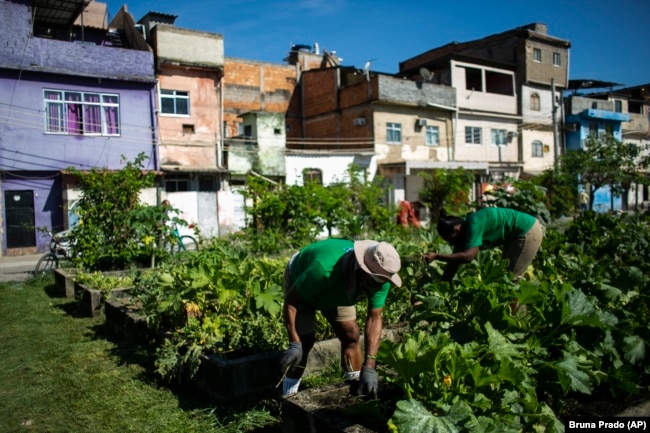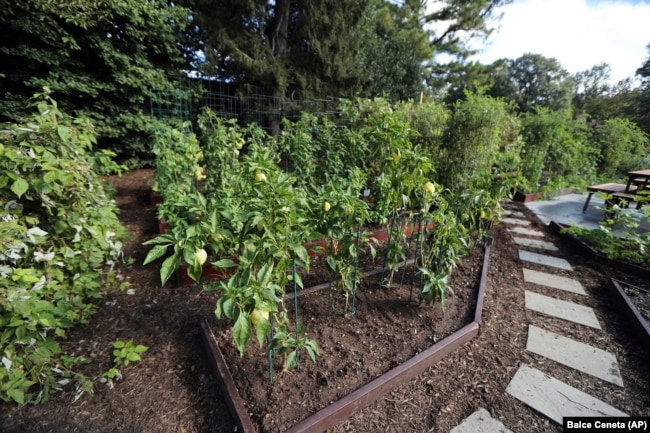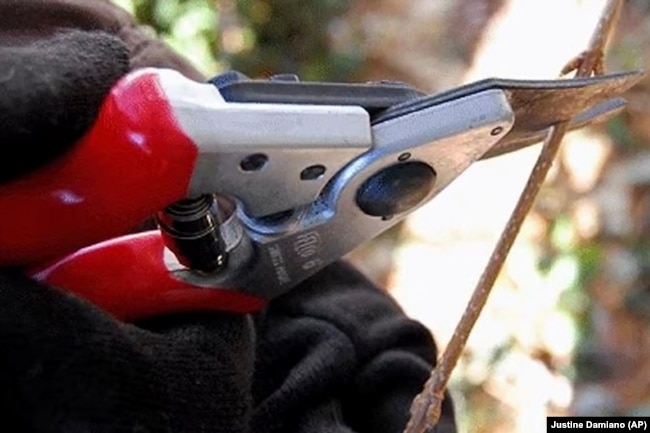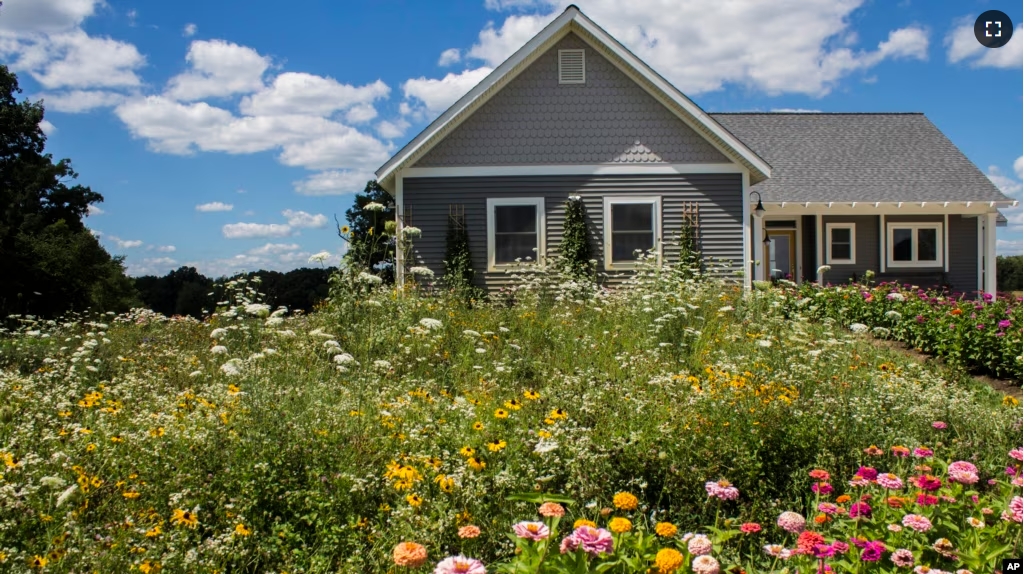From VOA Learning English, this is the Health & Lifestyle report.
For people who garden, April is an important month. Whether you live in the northern or southern hemisphere, weather and growing conditions change greatly in this time of year.
In the northern hemisphere, the weather generally is beginning to warm up. And in the southern hemisphere, the weather is generally beginning to cool down. So, gardening may look different in these two regions.
Today we give some general tips for working in an April garden, whichever hemisphere you might live in.

Southern hemisphere
The website Sustainable Gardening Australia gives suggestions on gardening in parts of the southern hemisphere.
At this time of year, weeding is important. If left unchecked, weeds can take space, water, sunlight, and nutrients from growing plants.
Mulching is also important and will help control weed growth. The website suggests mulching after watering to a depth of about 7cm and warns to keep the mulch away from baby plant stems.

At this time of year, experts say to water first thing in the morning. And, instead of quick daily waterings, longer watering two times a week might be more helpful.
What you plant depends on your climate. So, you need to check which plants grow at this time of the year in your zone, or area.
In cooler areas, experts on the website Sustainable Gardening Australia suggest planting Chinese cabbage, most Asian Greens, spinach, rocket, broccoli, spring onions, asparagus, celery, endive, squash, onions, leeks, and lettuce. Many herbs are suitable to plant at this time of year, such as parsley, basil, rosemary, thyme, and mint. However, keep an eye on mint as it can quickly take over.
Also in cooler areas, planting potatoes could work well.
Northern Hemisphere
In most parts of the northern hemisphere, things are coming to life in April. Trees, shrubs, perennials, and other plants enter a new phase of life in gardens. Garden insects do the same.
People who garden are also waking from a kind of dormancy, a state of rest, in spring. Now is the time for preparation.
Jessica Damiano writes about gardening for the Associated Press. She advises gardeners to get ready. “It’s showtime,” she writes of spring gardening.

Damiano suggests that the first step is to inspect your garden. Remove fallen tree branches you find. Remove dead wood from trees.
For pruning, she advises using a sharp pruning saw to make clean cuts on the diagonal, just outside the branch collar. This is the area where the branch meets the trunk. If the damage is within reach, she advises to do it yourself. But for anything higher than your head, she suggests using a tree cutting expert.
She says to prune shrubs, too, except for spring bloomers. Those should be pruned right after their flowers die.

What about cleaning up? Some people favor a tidy garden. But Damiano says gardeners should wait on removing dead plants and leaves if the ground temperature is still cool. Helpful insects, including pollinators, may be resting among these remains.
She notes that the insects react to temperatures and weather, not the calendar. Her suggestion is to avoid cleaning the garden until the insects are ready.
Damiano waits until nighttime temperatures have remained above 10 degrees Celsius for an entire week before cutting down last year’s dead plants.
This makes way for new growth while at the same time helps helpful insects survive.
She says there is some disagreement among experts about this timing because different species arise at different temperatures. But she finds waiting for warmer weather protects many insects while still permitting her to work in her garden.
Damiano also says gardeners should not mulch their beds until the soil has warmed. Using mulch too early can trap cooler temperatures in the soil. This could delay root awakenings.
Instead, mulch when tomatoes are planted in your area. In Damiano’s New York garden, that means late May.
Grass lawns
If you have a grass lawn, check for dead spots. Seed those areas once a week. Water twice a day until new growth meets the existing grass height. Do not let the seeds dry, or you may have to start over. You can cut seeded lawns when the grass is just under 8 centimeters tall.
Damiano suggests pulling weeds as soon as you see them. At this time of the year, the roots should be easy to remove. And avoid walking on wet soil. This could damage underground plant structures. Plants have a hard time recovering from such damage.

Flowers
When flowering bulbs lose color, apply a balanced fertilizer, such as a 10-10-10 product. This type of fertilizer contains equal parts of nitrogen, phosphorous, and potassium. As it contains all three nutrients, it usually works for most plants.
But do not remove leaves until they turn yellow. The plants need them to produce energy for next year’s bloom.
Damiano gives established perennials fertilizer as soon as they come out. She likes to use fertilizer made from fish parts.
Her final advice is to plant new perennials before the summer heat sets in. They may need six full weeks of growth. However, if you live in a part of the northern hemisphere where spring frosts are possible, do not plant annuals yet.
No matter where you live in the world, there is always something for a gardener to do. Doing some of these gardening jobs in April can help set up a healthy garden for the developing season.
And that’s the Health & Lifestyle report.
I’m Anna Matteo.
And I’m Andrew Smith
Jessica Damiano reported on gardening for the Associated Press. Anna Matteo adapted the report for VOA Learning English.
Quiz – April’s Gardening To-do List

Start the Quiz to find out
_________________________________________________
Words in This Story
region – n. a broad geographic area distinguished by similar features
weeding – v. to remove weeds or something harmful : weed – n. a plant that is not valued where it is growing and is usually of vigorous growth, especially one that tends to overgrow or choke out more desirable plants
mulching – v. to cover with mulch : mulch – n. a protective covering (as of sawdust, compost, or paper) spread or left on the ground to reduce evaporation, maintain even soil temperature, prevent erosion, control weeds, enrich the soil, or protect plants
zone – n. any of five great divisions of the earth’s surface with respect to latitude and temperature
perennial – adj. persisting for several years usually with new herbaceous growth from a
phase – n. a particular appearance or state in a regularly recurring cycle of changes
prune – v. to cut off or cut back parts of for better shape or more fruitful growth
diagonal – adj. running in a slanting direction
bloomer – n. a plant that blooms : bloom – v. to produce or yield flowers
bulb – n. a resting stage of a plant (such as the lily, onion, hyacinth, or tulip) that is usually formed underground and consists of a short stem base bearing one or more buds enclosed in overlapping membranous or fleshy leaves
frost – n. the process of freezing
